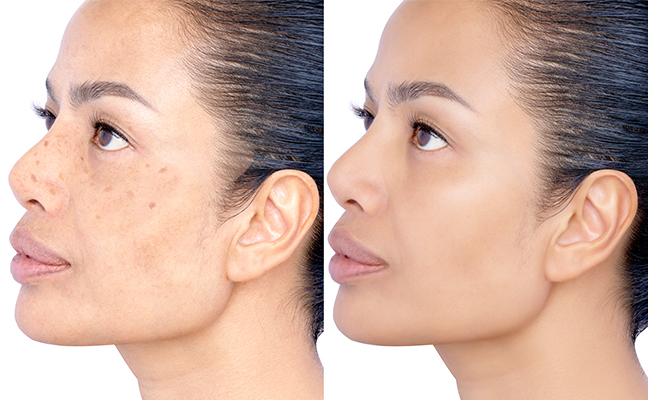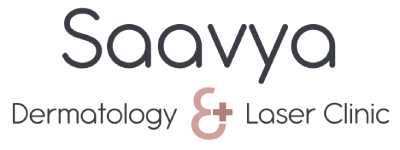Saavya Clinic: Proven Solution for Pigmentation Removal
Pigmentation Removal in Mumbai
What is Pigmentation
If the skin has too much melanin or overactive melanocytes, it darkens (a condition known as hyperpigmentation); if it has too little melanin or underactive melanocytes, it lightens (a condition known as hypopigmentation); and if it has no melanin, it lightens (a condition known as hypopigmentation) (a condition known as depigmentation).

What causes pigmentation?
- Hyperpigmentation is caused by many circumstances, including skin inflammation (post-inflammatory hyperpigmentation or PIH).
- Overload of iron in the skin (hemochromatosis).
- Pregnancy (mask of pregnancy or melasma).
- Birthmarks.
- Adrenal insufficiency (Addison’s disease)
- Overexposure to the sun or tanning.
- Certain drugs or treatments, such as birth control pills and chemotherapy.
- Skin irritation is one of the causes of hypopigmentation.
- Burns, ulcers, and blisters on the skin’s surface produce skin damage or discomfort.
- Certain medications.
- Clearly visible birthmarks
What are the types of skin pigmentation?
- Hypopigmentation is a condition in which the skin becomes lighter or whiter than usual. This is because melanin synthesis has decreased.
- Vitiligo is a kind of hypopigmentation in which smooth white patches emerge on the skin as a result of damaged pigment-producing cells. Although there is no cure for Vitiligo, there are numerous treatments available, including cosmetic masking.
- Albinism is a rare genetic illness characterized by the entire absence of melanin, resulting in a complete loss of pigmentation in the skin, hair, and eyes. Unfortunately there is no cure for Albinism.
- Hyperpigmentation is caused by an increase in melanin deposits in the dermis or epidermis, and occurs when regions of skin grow darker than the surrounding skin. Learn more about the treatment of hyperpigmentation and its causes.
- Melasma is a condition in which the skin’s pigmentation is unevenly produced, resulting in brown or black spots. While sun exposure is the most common cause, various medical and health conditions are also recognised triggers.
- Post Inflammatory Hyperpigmentation (PIH) is a skin discoloration caused by inflammation. Depending on the skin tone, PIH might show as pink, red, brown, or black patches. It is commonly caused by acne, a wound, rash, or pimple that produces skin irritation.
- Periorbital Melanosis: Also known as dark circles, this kind of skin discoloration occurs around the eyes. It is commonly inherited, however it may also be induced by stress or eye strain.
- Freckles are more evident on lighter complexions and are normally inherited; nevertheless, UV exposure may induce an overabundance of freckles.
- Photo-melanosis is induced by sun exposure and manifests as patchy pigmentation on the face, neck, back, and arms.
- Sunburn is a sort of reddish skin discoloration caused by excessive sun exposure that is more frequent among fairer skin tones.
Age spots-Sun damage to the skin causes age spots, liver spots, and lentigines. These lesions may be seen on the face, neck, and arms. - Protection from an early age is the only way to avoid developing these age spots.
What is the treatment for skin pigmentation?
Medical therapies for skin pigmentation issues include topical corticosteroids, UV light therapy, light-sensitive medicines, depigmentation, and, in certain cases, minor surgery.
Chemical Peel
This is a skin exfoliation therapy in which damaged skin cells are removed or peeled off the afflicted skin region using a chemical solution. It is a cosmetic surgery that helps to revitalize the skin, giving it a smooth, refreshing, and young appearance. Chemical peels are most typically used on the face, hands, and neck. Chemical peels are classified according to the strength of the chemical utilized and the degree of penetration. These include superficial (alpha-hydroxyl groups and mild acids), medium (trichloroacetic acid or glycolic acid), and deep chemical peels (like phenol). Age spots, mild skin discoloration, melasma, and freckles are best treated with a superficial or moderate chemical peel. This is a painless procedure that does not need anesthetic. It is a non-invasive, outpatient treatment that takes around 30 minutes and requires little to no recovery time.
Microneedling
It entails piercing the skin with sterilized microneedles on a micro pen or a derma roller and inflicting controlled small injuries. This therapy stimulates the natural wound healing process, resulting in skin cell renewal and the distribution of excess melanin pigment, which lightens the dark-colored patches. It is a safe and less intrusive technique. This therapy should be avoided by those who have damaged tissues or inflammatory skin since it may create consequences.
Toning using a Laser
To target the discolored skin during laser toning for pigmented skin, a Q-switched laser (a non-ablative variety) is employed. The laser beam creates heat, which promotes selective photothermolysis of melanocytes, which produce melanin pigment. Melanosome or pigment granule synthesis is considerably reduced, as is melanin transport to the skin through melanocytes. As a consequence, collagen remodeling is promoted, giving the skin a healthy, even tone. To get the ideal glowing skin tone, many treatments may be necessary.
Medical Facial or Medifacial
It is a diverse therapy that combines various cosmetic treatments, medical devices, and skin care items such as skin-lightening serums. This process is suitable for all skin types since it may be tailored to the demands of the particular skin type and skin issues. Although medi facials cannot address deep or chronic pigmentation, they may provide excellent results for superficial pigmentation such as tanning or post-inflammatory hyperpigmentation. Mostly, medical facial procedures require up to 1 hour and are associated with little or no downtime.
IPL (Intense Pulsed Light) Therapy
It’s also known as photo rejuvenation or photo facial. It may repair the damage or pigmentation caused by sun exposure and assist enhance the overall texture and tone of the skin. An intense, pulsing light energy (with more than one wavelength of light) is concentrated on the discolored regions of skin in this treatment. This induces heating of the afflicted skin layers, resulting in thermal death of the uppermost pigmented skin cells and ultimately aiding in the removal of undesirable melanocytes. As a consequence, after 10-14 days, the surface skin layers are replaced from underneath. The pulsated light energy also stimulates collagen and elastin formation in the skin, giving it firmness and elasticity. It is a rapid process that can cure large pigmented regions efficiently and safely. Because the light is delivered in brief pulses, only a faint feeling is felt throughout the procedure. To remove the pigmentation, many sessions (approximately 1 to 4 treatments) are necessary.
Mesotherapy
The therapy employs novel pharmaceutical chemicals, natural drugs, plant extracts, vitamins, and other substances that are injected just under the skin’s surface layer. The unique components are applied directly to the target skin region during the therapy. This therapy is useful for treating skin pigmentation issues such as melasma, pimples, freckles, and post-inflammatory hyperpigmentation.
This treatment’s composition may brighten the skin, suppress melanin synthesis, and aid in the elimination of free radicals. Although effects may be seen with only one treatment, a course of up to 3-5 sessions at regular intervals is suggested for best outcomes.
Microdermabrasion
This treatment softly exfoliates the skin’s surface layer, allowing for enhanced active-ingredient penetration. It also promotes cell regeneration, collagen formation, skin elasticity, and tone.
